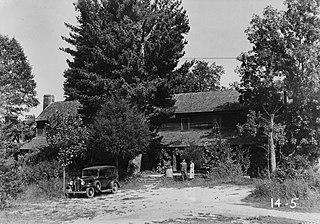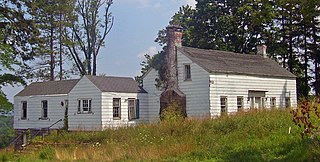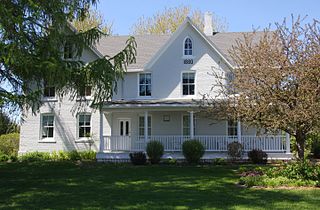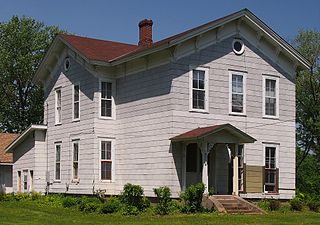
Travelers Rest State Historic Site is a state-run historic site near Toccoa, Georgia. Its centerpiece is Traveler's Rest, an early tavern and inn. It was designated a National Historic Landmark on January 29, 1964, for its architecture as a well-preserved 19th-century tavern, and for its role in the early settlement of northeastern Georgia by European Americans.

The First Congregational Parsonage is a former clergy house in Wabasha, Minnesota, United States. It was built in 1872 and listed on the National Register of Historic Places in 1982 for being one of the city's finest examples of a frame Italianate building. However, in 1987 it was moved from its original location at 305 Second Street West due to construction of the Wabasha–Nelson Bridge. Removed from its historic context in a riverfront residential district, the parsonage was delisted from the National Register in 1992.

The Whitney Tavern Stand served as an inn and local gathering place in Cascade Township, Michigan for fifty years after its construction in the 1852-53 period. In its first few years it served as a stop for stagecoaches on the lines that, connecting Battle Creek, Hastings, and Kalamazoo with Grand Rapids, passed through Whitneyville. It is listed in the National Register of Historic Places.

Cannondale Historic District is a historic district in the Cannondale section in the north-central area of the town of Wilton, Connecticut. The district includes 58 contributing buildings, one other contributing structure, one contributing site, and 3 contributing objects, over a 202 acres (82 ha). About half of the buildings are along Danbury Road and most of the rest are close to the Cannondale train station .The district is significant because it embodies the distinctive architectural and cultural-landscape characteristics of a small commercial center as well as an agricultural community from the early national period through the early 20th century....The historic uses of the properties in the district include virtually the full array of human activity in this region—farming, residential, religious, educational, community groups, small-scale manufacturing, transportation, and even government. The close physical relationship among all these uses, as well as the informal character of the commercial enterprises before the rise of more aggressive techniques to attract consumers, capture some of the texture of life as lived by prior generations. The district is also significant for its collection of architecture and for its historic significance.

The Checkerboard Inn, also known as the Forshee-Jenkins House, is a late 18th-century frame building located on Mansion Ridge Golf Club in Monroe, New York, United States. Originally built as a house, within a decade it went into service as an inn when the Orange Turnpike, an early toll road through the area, opened in 1802. It takes its name from an early owner's reputed decision to paint it in a checkerboard pattern to attract business, although this has not been conclusively established.

The Historic Anderson House Hotel is a hotel and event venue in Wabasha, Minnesota, United States. The hotel opened in 1856 and was Minnesota's oldest continuously operating bed and breakfast inn west of the Mississippi River. Most of the furniture dates back to 1856 as well. The building was expanded in 1887. It was listed on the National Register of Historic Places as the Hurd House–Anderson Hotel in 1978 for having local significance in the theme of commerce. It was nominated for being a prominent and long-operating business originating in the years of Wabasha's rapid growth as a river and rail transportation hub. In 1982 it was also listed as a contributing property to the Wabasha Commercial Historic District.

Thompson's Opera House, also known as Brown's Hall, Brown's Opera House or the Gem Theater, is a small theater building in Pioche, Nevada. The Opera House is a wood-frame building built in 1873, attached roughly to the adjoining brick Gem Theater, a 1937 masonry cinema.

The Sibley Historic Site is the site of Henry Hastings Sibley's home, who was the regional manager of the American Fur Company and Minnesota's first governor. It is one of the 26 historical sites that are operated by the Minnesota Historical Society. Located in what is now the city of Mendota, the site consists of four limestone buildings and a large lawn area. Three of the buildings are open for touring, including a fur company cold store from 1843 and the 1840 home of fur trader and hotelier Jean-Baptiste Faribault.

Clark–Dearstyne–Miller Inn is a historic inn and tavern located at Rensselaer in Rensselaer County, New York. It was built about 1791 and is a 2+1⁄2-story, rectangular, gable-roofed heavy timber frame building. It rests upon a fieldstone foundation. There is a 2-story, shed roof addition to the rear. It features an ornate, bracketed, raised porch along the front facade added about 1880. The building exhibits a number of vernacular Federal details.

The Osmund Osmundson House is a historic house in Nerstrand, Minnesota, United States. The private home was placed on the National Register of Historic Places (NRHP) on April 6, 1982. The house is significant for its association with a prominent Rice County pioneer and town founder.

The Ault Store is a historic commercial building in Dundas, Minnesota, United States. The building was placed on the National Register of Historic Places (NRHP) on April 6, 1982.

The Bemidji Carnegie Library is a former library building in Bemidji, Minnesota, United States. It was built as a Carnegie library in 1909 and housed the city's public library until 1961. It was listed on the National Register of Historic Places in 1980 for its local significance in the themes of architecture and education. It was nominated for being a well-preserved example of a Carnegie library and of public Neoclassical architecture.

The Red Fox Inn & Tavern, also known as the Middleburg Inn and Beveridge House, is a historic inn and tavern located in Middleburg, Loudoun County, Virginia. According to the National Register of Historic Places placard on the building, the Red Fox Inn was established circa 1728. Some historic artifacts on the building date to about 1830, with additions and remodelings dating from the 1850s, 1890s, and the 1940s. It consists of a 2 1/2 story-with-basement, five-bay, gable-roofed, fieldstone main block, with a two-story, three-bay, gable-roofed fieldstone rear wing. The front facade features a one-story, one-bay, pedimented porch dating from the 1940s. It has a standing seam metal gable roof and exterior end chimneys. The buildings exhibits design details in the Federal and Colonial Revival styles. It is thought to be one of the oldest continuously operated inns in Virginia as well as the United States. The Red Fox Inn & Tavern has served a variety of functions including: stagecoach stop, inn, tavern, butcher shop, apartment house, post office, and hotel.

Hotel Indigo Atlanta Midtown is a historic building in midtown Atlanta, Georgia. Designed by Atlanta-based architectural firm Pringle and Smith in 1925, the brick building is located on Peachtree Street, across from the Fox Theatre. It has been listed on the National Register of Historic Places since 2006, and, in 2022, is a member of Historic Hotels of America.

The John P. Furber House is a historic house in Cottage Grove, Minnesota, United States, built in 1871, the same year Furber officially platted the 20-year-old settlement. It was listed on the National Register of Historic Places in 1982 for having local significance in the theme of community planning and development. It was nominated for its association with the phenomenon in early Washington County towns of platting well after communities had already been established.

The Williamson–Russell–Rahilly House is a historic house in Lake City, Minnesota, United States. The original core of the house was built in Greek Revival style around 1868, but it was extensively remodeled in Neoclassical style in 1910. The house was listed on the National Register of Historic Places in 1984 for having local significance in the theme of architecture. It was nominated as a particularly fine example of Minnesota's elegant, turn-of-the-20th-century architecture.

Simons' Inn, also known more recently as Rowell's Inn, is a historic traveler's accommodation on Vermont Route 11 in Andover, Vermont. Built in 1826, it is a remarkably well-preserved example of a 19th-century stagecoach inn. It has for many years been a local community meeting point, serving as a general store and post office until 1950. It was listed on the National Register of Historic Places in 1979. It is now a private residence.

The Sandenburgh-Rogers Summer Resort Complex, also known as the Interlochen Cottage, is a private summer home located at 2046 Crescent Beach Road in Williamsport, Michigan. It was listed on the National Register of Historic Places in 1996.

The Erastus Bolles House is a historic house in Afton, Minnesota, United States. It was built in 1856 in what was then the separate community of Valley Creek. The house was listed on the National Register of Historic Places in 1982 for its local significance in the themes of architecture and exploration/settlement. As one of the original houses in Valley Creek, it was nominated for helping to depict one of the many small Washington County settlements that formed around a commercial venture—though one that never progressed to formal platting—and the community's two-decade preference for Greek Revival architecture. Valley Creek was later formally incorporated into Afton.

The Newington Gilbert House is a historic house in Afton, Minnesota, United States. It was built in 1864 in what was then the separate community of Valley Creek. The house was listed on the National Register of Historic Places in 1982 for its local significance in the themes of architecture and exploration/settlement. As one of the original houses in Valley Creek, it was nominated for helping to depict one of the many small Washington County settlements that formed around a commercial venture—though one that never progressed to formal platting—and the community's two-decade preference for Greek Revival architecture. Valley Creek was later formally incorporated into Afton.
























